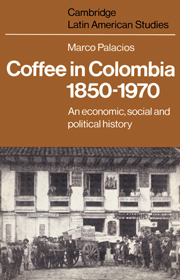Book contents
- Frontmatter
- Contents
- List of tables
- List of figures
- List of maps
- Preface
- Acknowledgements
- 1 The Colombian export economy in the second half of the nineteenth century
- 2 The making of an oligarchy
- 3 Land and society in central Colombia in the second half of the nineteenth century
- 4 The internal structure of the coffee haciendas, 1870–1930
- 5 Living conditions and internal contradictions in the hacienda structure
- 6 Inflation, devaluation, and export taxes, 1870–1904
- 7 Crisis and transition towards the second cycle of expansion, 1903–10
- 8 Private appropriation of public lands in the west
- 9 Sociopolitical elements in antioquen̄o colonization
- 10 Coffee expansion and the strengthening of the Liberal model of development, 1910–50
- 11 The international cycle and coffee policies confronting the peasant, 1930–70
- Appendix 1 Sample of coffee estates in Cundinamarca and Antioquia, 1870–98
- Appendix 2 Piece-rate wages on two coffee haciendas, 1879–1933
- Appendix 3 Concentration of the coffee export trade (percentage controlled by 20 leading companies), 1933–70
- Appendix 4 Foreign exchange rates in Colombia, 1870–1970
- Weights and measures
- Glossary
- Notes
- Biblography
- Index
- CAMBRIDGE LATIN AMERICAN STUDIES
10 - Coffee expansion and the strengthening of the Liberal model of development, 1910–50
Published online by Cambridge University Press: 06 October 2009
- Frontmatter
- Contents
- List of tables
- List of figures
- List of maps
- Preface
- Acknowledgements
- 1 The Colombian export economy in the second half of the nineteenth century
- 2 The making of an oligarchy
- 3 Land and society in central Colombia in the second half of the nineteenth century
- 4 The internal structure of the coffee haciendas, 1870–1930
- 5 Living conditions and internal contradictions in the hacienda structure
- 6 Inflation, devaluation, and export taxes, 1870–1904
- 7 Crisis and transition towards the second cycle of expansion, 1903–10
- 8 Private appropriation of public lands in the west
- 9 Sociopolitical elements in antioquen̄o colonization
- 10 Coffee expansion and the strengthening of the Liberal model of development, 1910–50
- 11 The international cycle and coffee policies confronting the peasant, 1930–70
- Appendix 1 Sample of coffee estates in Cundinamarca and Antioquia, 1870–98
- Appendix 2 Piece-rate wages on two coffee haciendas, 1879–1933
- Appendix 3 Concentration of the coffee export trade (percentage controlled by 20 leading companies), 1933–70
- Appendix 4 Foreign exchange rates in Colombia, 1870–1970
- Weights and measures
- Glossary
- Notes
- Biblography
- Index
- CAMBRIDGE LATIN AMERICAN STUDIES
Summary
The continuous growth of the production of coffee between 1910 and 1960 is the most decisive phenomenon in the recent economic history of Colombia. The country became the second most important world supplier of coffee, and the most important supplier of mild coffees. The impact of coffee expansion on economic growth, on the diversification of the productive and occupational structure, and on the distribution of income among classes, groups, and regions is therefore central to contemporary historical analysis. Given the present state of research, it is impossible to give a full and precise account of this impact and of the multiple relationships between the coffee sector and the rest of the sectors of the Colombian economy. Many themes still remain unstudied and require the slow construction of time-series and the systemization of basic document sources. Even then, it would be odd to write about coffee in Colombia without making ample reference to the external parameters by which it is circumscribed.
During the First World War, Colombia became a first-order coffee exporting country. The annual average of production between 1915 and 1917 was 800,000 bags of 60 kg. The annual rate of growth of Colombian production from 1915-17 to 1970-2 was 4.2 per cent, against an annual growth of world consumption averaging 2.2 per cent for the same period. It was logical that the highest rates of growth should have been reached in the earlier periods.
- Type
- Chapter
- Information
- Coffee in Colombia, 1850–1970An Economic, Social and Political History, pp. 198 - 226Publisher: Cambridge University PressPrint publication year: 1980



